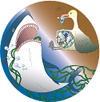Outline and Overview
Survey implementation guidelines
The Survey of Washed-up Debris on Beaches implementation guidelines 2008

1. Purpose
The surveys are intended to provide elucidation of the extent of coastal pollution caused by artificial objects such as plastic items, through collecting and sorting debris and other objects washed ashore along Japan's coastline, and examining the number and weight by type. The results are also used as basic data for the promotion of future marine environment preservation, fishery conservation, measures against waste products, and other related activities.
Furthermore, through participation in the survey, it is expected that environmental education will be encouraged among local inhabitants of coastal regions by creating a common awareness toward developing the attitude not to litter and to protect the marine environment.
2. Survey period and frequency
・Once per year during autumn (ordinarily September–November)
・Survey should be carried out about one month after the peak season for the beach has finished.
3. Survey target areas
Coasts of the Northeast Asia region (Japan, China, South Korea, and Russia)
4. Requirements of the survey beach
(1) Two locations should be selected as the survey beaches in each prefecture.Where feasible, it is preferable to select beaches where surveys have been conducted previously.
In cases such as where surveys are conducted by different participating organizations, more than one survey is allowed at a given beach; however, the survey periods and blocks should differ.
(2) As a general rule, the survey beaches should be sandy beaches that allow the participants to conduct safe activities. Furthermore, beaches that fall under any of the following conditions should be excluded for accurate data comparisons unless there is some special reason.
1) A beach located within 1 km either side of the mouth of a large river
2) A beach in front of which wave breakers or other obstacles are placed
5. Survey method
(1) Survey of washed-up debris
1) As a general rule, set approximately three continuous ten-by-ten meter blocks in an inland direction from the water's edge (hereafter referred to as "survey blocks") as the survey area (approximately 30 meters from the water's edge).
2) Classify the washed-up debris (artificial objects) from each survey block into the following eight major categories, count the number, and measure the weight. Furthermore, separate objects in each subcategory between those made in your own country and those from overseas based on the letters printed on them and count their numbers.
1) Plastic items
2) Rubber items
3) Styrene foam items
4) Paper items
5) Textile items
6) Glass and ceramic items
7) Metal items
*1 While the survey targets artificial objects washed up on beaches, natural objects (driftwood, seaweed, other plants, etc.) may also be included at the discretion of the organizer.
6. Submission of survey results and other related data
(1) The organizations conducting the survey are required to send the following items to the Northwest Pacific Region Environmental Cooperation Center (hereinafter referred to as "NPEC") within one month after the survey has been completed.
1) Map of the area surrounding the survey beach
2) List of participating organizations
3) Survey beach data sheet outlining the conditions of the beach to be surveyed
4) Survey summary sheets filled in with survey results
5) Photos of the survey beach, survey activity, etc.
6) Report on the state of the implementation of environmental education (optional)
7) Results of questionnaire to the participants (including the form and collected results) (optional)
Note: These items should be sent as electronic files wherever possible. Item 1) may be omitted for the survey points where the surveys have been conducted successively.
(2) NPEC will compile the survey results and prepare reports and other documents.
7. Work to be done by the participating organizations and expense of the survey
(1) The work to be done by the organizations conducting the survey includes: selecting the survey locations, recruiting participants (groups and individuals), explaining the survey methods to the participants, conducting the survey, and compiling the results of the survey of washed-up debris (entering onto the sheets).
(2) Equipment and materials necessary for the survey will be provided in kind by NPEC to the organizations conducting the survey.
Tape measures, rulers, scales (2-kg and 8-kg types), nylon cord (to indicate the survey area), cotton work gloves, tongs, tweezers, plastic trays, plastic zipper-top bags, stakes, garbage bags, oil-based permanent markers, binders, blue tarpaulins, packing tapes, megaphones, first-aid kits
(3) Part of the direct expenses, such as for transportation of participants, drink, and photographic developing, will be met by NPEC upon deliberation.
Note:For details, please refer to the "20XX Survey Implementation Guidelines for the Survey of Washed-up Debris on Beaches" that are to be sent annually.




